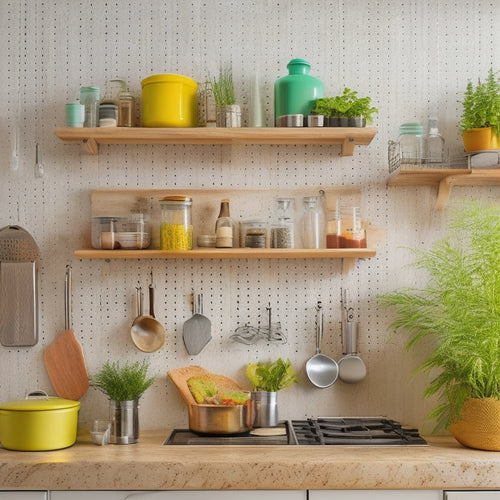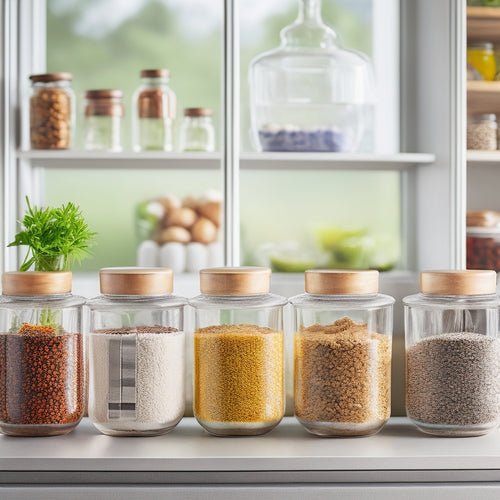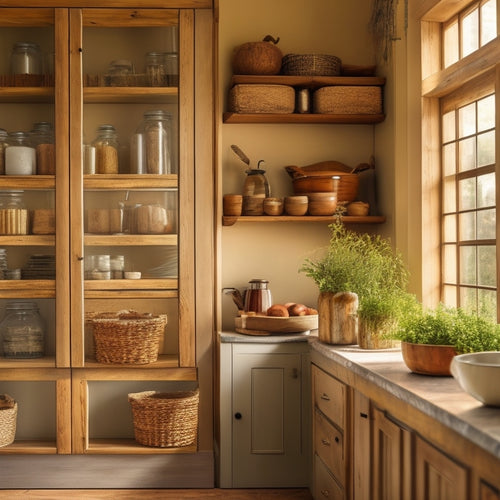
10 Essential Tips for Tidy Kitchen Cabinets
Share
You're tired of wasting time searching for kitchen essentials in cluttered cabinets. To transform your kitchen into a haven of efficiency and organization, start by purging unwanted items and categorizing essentials by frequency of use. Assign a home for each item, utilizing vertical storage space and optimizing cabinet shelf divisions. Implement a 'one in, one out' rule to maintain your space. Clearly label cabinet contents, and keep frequently used items near the front. Finally, schedule regular cabinet maintenance to prevent clutter from building up again. By following these essential tips, you'll be well on your way to a tidy kitchen that sparks joy - and that's just the beginning.
Key Takeaways
• Purge unwanted items by sorting into keep, donate/sell, and discard piles to create a more organized kitchen cabinet space.
• Categorize items by frequency of use, grouping essentials and special-occasion items separately, and implement a seasonal rotation for infrequently used items.
• Assign homes for items by creating personalized zones for frequently used items and designating customized compartments for items stored together.
• Utilize vertical storage space by maximizing shelf space with stackable containers and hanging infrequently used items from the ceiling.
• Label each shelf and cabinet clearly, using a consistent design and color coding, to easily identify contents and maintain a clutter-free cabinet.
Purge Unwanted Kitchen Items First
Before you start organizing your kitchen cabinets, take everything out and sort items into three piles: keep, donate/sell, and discard. This important step helps you tackle kitchen clutter head-on. Be honest with yourself – if you haven't used it in the past year, it's probably safe to let it go.
The 'keep' pile should only contain items that bring you joy or serve a purpose. The 'donate/sell' pile is perfect for gently used items that can find a new home, and the 'discard' pile is for broken or useless items.
Consider turning your 'donate/sell' pile into a Donation Station. Set up a designated area in your home where you can collect items to donate or sell. This will encourage you to regularly purge unwanted items and make a positive impact on your community.
Categorize Items by Frequency Used
With your kitchen items purged, it's time to categorize what's left by how frequently you use them, grouping essentials like daily dishes and cooking staples together, and relegating special-occasion items to their own section. This step helps you prioritize what you need quick access to, making cooking and meal prep more efficient.
Consider implementing a seasonal rotation for infrequently used items, like holiday-themed dishes or summer BBQ gear, to free up space and reduce clutter. As you categorize, think about your personal preference for workflow and accessibility. If you're a morning person, store your coffee maker and breakfast essentials in an easy-to-reach spot. If you bake frequently, group all your baking supplies together for convenience.
Be honest with yourself about how often you use each item – if you haven't used it in the past year, it might be time to relegate it to a harder-to-reach shelf or consider donating it. By categorizing your kitchen items by frequency of use, you'll create a more functional and organized kitchen that makes serving others a breeze.
Assign Home for Each Item
Now that you've categorized your kitchen items by frequency of use, it's time to assign a home for each item, ensuring that everything has a designated place that makes sense for your workflow and daily routines. This step is vital in maintaining a tidy kitchen cabinet. By assigning a home for each item, you'll avoid clutter and make cooking a breeze.
Here are some tips to help you assign a home for each item:
-
Create Personalized Zones for frequently used items, like coffee mugs or cooking utensils, near the area where you'll be using them.
-
Designate Customized Compartments for items that need to be stored together, such as baking supplies or spices.
-
Store heavy items at the bottom of cabinets to prevent them from falling and causing a mess.
-
Keep similar items together, like all your cookbooks on one shelf.
-
Label each zone or compartment so you can easily find what you need.
Utilize Vertical Storage Space
When organizing your kitchen cabinets, you'll want to make the most of the space you have.
You can do this by maximizing your shelf space and optimizing the height of your cabinets.
Max Out Shelf Space
You can greatly increase your kitchen cabinet's storage capacity by optimizing its vertical space. By doing so, you'll be able to store more items without cluttering your countertops or sacrificing floor space.
Here are some tips to help you max out your shelf space:
-
Double up with stackable containers: Use containers that can be stacked on top of each other to store dry goods, baking supplies, or snacks.
-
Install shelf liners: Add a layer of protection and ease of cleaning with shelf liners that can be wiped down or replaced when needed.
-
Use adjustable shelves: Customize your shelf heights to fit different-sized items, making the most of your cabinet's vertical space.
-
Hang items from the ceiling: Suspend baskets, hooks, or racks from the ceiling to store infrequently used items, keeping them out of the way but still accessible.
-
Label and categorize: Organize your shelf contents by category and label each section to ensure easy retrieval and maintain your tidy cabinet.
Optimize Cabinet Height
Optimize Cabinet Height
By strategically placing frequently used items at waist level and reserving higher and lower shelves for less frequently used or seasonal items, you can optimize your cabinet height to reduce straining and bending while cooking. This thoughtful arrangement allows you to access essential items easily, saving time and energy.
Take precise cabinet measurements to determine the ideal shelf adjustment for your needs. Typically, the most accessible shelf should be between 30 and 40 inches from the floor, with heavier items placed at the bottom and lighter ones at the top.
Adjust your shelves accordingly to create a comfortable and efficient cooking environment. For instance, store heavy cookware at the bottom, followed by frequently used dishes and utensils at waist level. Reserve higher shelves for infrequently used or seasonal items, such as special occasion dishes or holiday-themed cookware.
Optimize Cabinet Shelf Divisions
Divide your cabinet shelves into zones, assigning a specific category of items to each section, to maintain a sense of order and make the most of your storage space. This will help you quickly locate what you need and prevent clutter from building up.
To take your cabinet organization to the next level, consider these tips:
-
Use shelf liners to protect your shelves from spills and stains, making cleanup a breeze
-
Install adjustable compartments to accommodate items of different sizes and shapes
-
Designate a 'junk drawer' for miscellaneous items to keep them out of the way
-
Store frequently used items in easy-to-reach zones
-
Label each zone so everyone in the household knows where things go
Store Heavy Items at Bottom
Storing heavy items at the bottom of your cabinet shelves prevents them from falling and causing damage or injury. This simple yet effective tip can save you from a lot of trouble in the long run.
Heavy items, such as pots, pans, and cookbooks, can be a hazard if they're not stored properly. By keeping them on the bottom shelves, you're reducing the risk of them falling and causing harm to yourself or others.
Additionally, storing heavy items at the bottom makes it easier for you to access them without having to do any heavy lifting. This is especially important if you have mobility issues or if you're short on storage space. You'll be able to retrieve what you need without straining your back or struggling to reach high shelves.
Implement a "One In, One Out" Rule
To maintain the organized space you've created by storing heavy items at the bottom, adopt a rule that will help you keep your kitchen cabinets clutter-free in the long run: implement a 'one in, one out' policy.
This means that for every new item you bring into your cabinet, you must remove or donate an old one. This rule requires personal discipline, but it's crucial for maintaining a tidy kitchen.
Here are some benefits of adopting this rule:
- You'll avoid clutter buildup and keep your cabinets organized
- You'll reduce decision fatigue when searching for items
- You'll save time and money by avoiding duplicate purchases
- You'll develop more mindful shopping habits, buying only what you need
- You'll create a sense of calm and control in your kitchen, making meal prep and cooking more enjoyable
Label Cabinet Contents Clearly
Now that you've purged your cabinets of unnecessary items, it's time to get organized.
You'll want to label the contents of your cabinets clearly, so you can easily find what you need when you need it.
Labeling Made Easy
You can easily achieve a sense of order in your kitchen cabinets by labeling their contents clearly, ensuring you can quickly identify what's inside without having to dig through everything. This simple step can save you time and reduce stress in the kitchen.
To get started, consider the following tips to make labeling a breeze:
-
Choose a consistent Label Design: Pick a style that fits your kitchen's aesthetic, and stick to it for a cohesive look.
-
Use Color Coding: Assign different colors to different categories (e.g., baking supplies, snacks, etc.) to create a visual system that's easy to follow.
-
Keep it Simple: Use short, descriptive labels that get straight to the point.
-
Don't Forget the Back: Label the back of shelves and cabinets too, so you can see what's stored there at a glance.
-
Make it Easy to Update: Use removable labels or a label maker with erasable ink, so you can easily change labels as your kitchen contents evolve.
Categorize by Frequency
Organize your kitchen cabinet contents by categorizing items based on how frequently you use them, ensuring that everyday staples are easily accessible and less-used items are relegated to harder-to-reach areas. This approach helps you prioritize your kitchen essentials, making meal prep and cooking a breeze.
By tracking your frequency of use, you'll identify patterns in your cooking habits, allowing you to optimize your cabinet layout.
Start by grouping similar items together, such as baking supplies or cooking utensils. Then, within each group, arrange items in order of frequency of use. For instance, place your most-used spices or oils in easy-to-reach areas, while less-used items are stored towards the back or on higher shelves.
This system enables you to quickly locate the items you need, saving you time and effort in the kitchen. By categorizing by frequency, you'll create a more functional and efficient kitchen space that supports your cooking needs.
Identify Hidden Items
Cabinet contents often remain hidden from view, making it difficult to remember what's stored within, so labeling each shelf and cabinet clearly is essential to maintain a tidy kitchen. This is especially true for those hard-to-reach hidden corners and secret compartments where items tend to get lost or forgotten.
By labeling your cabinets, you'll be able to quickly identify what's inside, reducing the time spent searching for that one specific item.
Here are some benefits of labeling your cabinet contents:
- Reduces frustration and stress when searching for items
- Saves time and increases productivity in the kitchen
- Helps maintain a sense of organization and control
- Enables you to identify expired or unused items
- Allows you to easily restock and replenish items as needed
Keep Frequently Used Near Front
Frequently grabbed items, like olive oil or spices, earn prime real estate at the front of your shelves, ensuring easy access and streamlining meal prep. This front organization approach allows you to quickly find what you need, reducing cooking time and stress.
By keeping essentials within easy reach, you'll spend less time digging through cabinets and more time focusing on what matters – serving delicious meals to your loved ones.
To maximize front organization, categorize your frequently used items and group them together. Store them in airtight containers or bins with clear labels, making it easy to identify contents. This will also help you maintain a clutter-free cabinet and prevent items from getting lost or expired.
Schedule Regular Cabinet Maintenance
To keep your kitchen cabinets running like a well-oiled machine, it's important you set aside time to give them a thorough once-over, ensuring everything stays tidy and in its place. This regular maintenance is vital to achieving your Cabinet Goals and maintaining a Maintenance Mindset. By doing so, you'll avoid clutter buildup, reduce stress, and make meal prep a breeze.
Here are some reasons why regular cabinet maintenance is a must:
-
Stay organized: Regular cleaning and organization help you quickly find what you need, saving time and reducing frustration.
-
Prevent pests: Crumbs and spills can attract unwanted critters; regular cleaning keeps them at bay.
-
Reduce waste: Expired or spoiled food can be a real problem; regular checks help you stay on top of expiration dates.
-
Save money: By keeping track of your inventory, you'll avoid duplicate purchases and reduce food waste.
-
Enjoy cooking: A tidy kitchen is a happy kitchen! Regular maintenance helps you focus on the joy of cooking, not the stress of clutter.
Frequently Asked Questions
How Do I Decide What Kitchen Items to Keep and What to Discard?
"What's holding you back from letting go of that old kitchen gadget? Establish purge criteria, considering frequency of use and functionality, to help you overcome emotional attachment and make intentional decisions about what stays and what goes."
Can I Use Baskets or Bins to Store Items in My Cabinets?
You can definitely use baskets or bins to store items in your cabinets, and consider label options to keep contents organized. Choose from various basket styles, like woven, fabric, or wooden, to fit your kitchen's aesthetic and functional needs.
How Often Should I Clean and Reorganize My Kitchen Cabinets?
You'll want to clean and reorganize your kitchen cabinets every 2-3 months to combat Cabinet Creep, and consider a Seasonal Purge to refresh your space and maintain a clutter-free kitchen that sparks joy and efficiency.
Are There Any Specific Cabinet Organizers I Should Invest In?
You've likely wondered if there's a scientific basis for the perfect cabinet organization system. Research suggests a tailored approach yields maximum efficiency. Invest in adjustable shelves and custom inserts to maximize your space and reduce clutter.
Can I Apply These Tips to My Pantry Organization as Well?
"You can definitely apply these tips to your pantry organization! Consider your pantry layout and explore customization options to maximize storage, ensuring everything has a designated spot, making it easier to serve others from a place of peace."
Related Posts
-

Stylish Pegboard Storage for Open Kitchen Concepts
Stylish pegboard storage can completely enhance your open kitchen concept, merging practicality with contemporary fla...
-

Stackable Kitchen Containers for Dry Goods
Stackable kitchen containers are perfect for organizing dry goods and maximizing your kitchen space. They help reduce...
-

Freestanding Pantry Units for Farmhouse Kitchen Style
Freestanding pantry units perfectly blend beauty and function in your farmhouse kitchen. They maximize storage while ...


